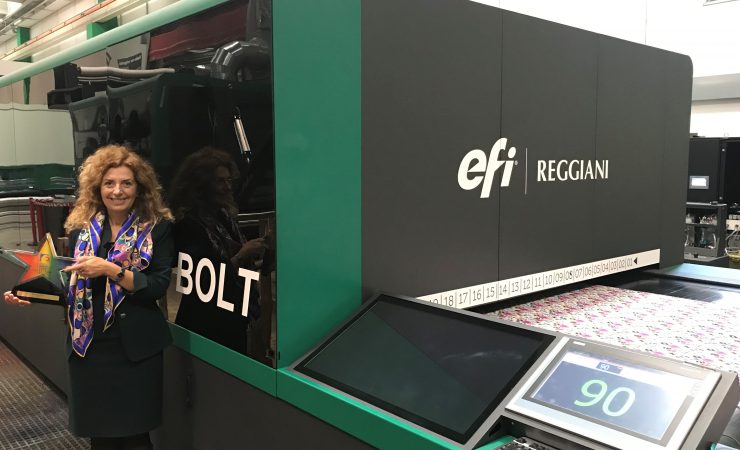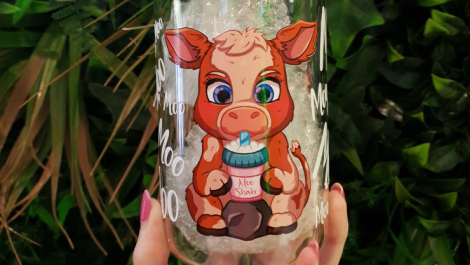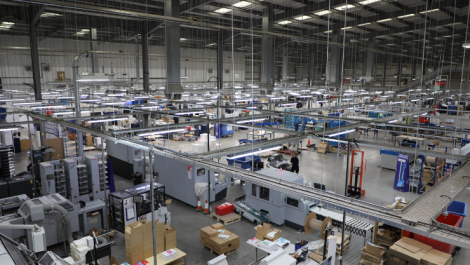The digital print sector takes its environmental responsibilities seriously, constantly innovating to boost the industry’s green credentials. But, with digital print becoming an ever larger part of the textiles market, and more and more printers moving into that space, it’s important that everyone is aware of the impact that textile production has on our planet and the steps digital printers can take to mitigate that impact. Charlie Kortens reports
It’s impossible to say precisely how much damage the global textile industry does to this planet. You can get different statistics from different sources, but everyone agrees it’s horrendous. Indeed at times it seems those different sources seem to be competing to see who can make the situation sound the most egregious.
According to American news site Vox, 8 – 10% of all global greenhouse emissions come directly from the fashion industry, more than the aviation and shipping industries combined. It goes on to claim that the fashion industry produces between 80 and 150 billion garments in any given year, of which three-fifths are destined for an incinerator or landfill.
If you prefer, take your information from EcoWatch, a site devoted exclusively to keeping people up to date with environmental news. It says that the clothing industry is the second largest polluter in the world, behind only oil. It adds that cotton, the world’s most commonly used natural fibre, is one of the most chemically dependent crops we have. While only 2.4% of the world’s cropland is planted with cotton, it consumes 10% of all agricultural chemicals and 25% of insecticides.
Just to hammer the point home, Business Insider says that ‘fashion production makes up 10% of humanity’s carbon emissions, dries up water sources, and pollutes rivers and streams. What’s more, 85% of all textiles go to the dump each year. And washing some types of clothes sends thousands of bits of plastic into the ocean.’ Business Insider reports that the equivalent of one rubbish truck full of clothes is burned or dumped in a landfill every single second.
Digital printing
The good news, such as it is, is that digital printing is becoming ever more important within the textile market, and those involved with digital are insisting that both the technology as a whole, and their own innovations in particular, are building a chance to make textiles greener.
‘Fashion is one of the most environmentally unfriendly industries on the globe,’ Epson’s UK sales manager Phil McMullin says. ‘Digital technology is helping businesses take responsibility for this impact and drag the industry kicking and screaming into the 21st century. Sustainability has been one of the underlining foundations for Epson’s dye-sublimation, direct-to-garment and direct-to-fabric digital printing technologies.’
It’s a view echoed by some of the other major players in the digital textiles space, as EFI Reggiani’s Adele Genoni explains, ‘We are seeing a definite rise in green awareness and that fits in with our own vision of becoming more productive, more efficient and more sustainable. Logistics chains are getting shorter and production is being moved closer to the consumer. Overall it’s a great opportunity to promote quality printing that uses less water and has less waste, it all suits digital.’

Epson’s Phil McMullin
HP’s Johan Spies, WW & EMEA low volume product manager, textiles, adds, ‘2020 saw design professionals at the forefront of environmental consciousness; and now consumers and regulators are also placing higher value on sustainable credentials making it a trend that is set to shape the year ahead.’
The truth
This all sounds good, but can digitally printed textiles really meet the quality demanded by leading brands and consumers, whilst being more sustainable at the same time?
It is hard to get precise figures, and digital is still a relatively new fish in the textile pond, but the initial evidence suggests the answer is yes. Some of the most significant advantages digital boasts over its rivals, most notably screen and rotary printing, are its lack of waste. There is water, where literally dozens of litres can be saved per square metre printed – according to Fespa, the growth of digital textile printing saved in total over 40 billion litres of water worldwide in 2018 – and there are ink, energy and media benefits as well.
Digitally printed textiles, whether they use pigment inks or water-based inks, can claim to be more environmentally friendly by being either used in smaller amounts (the former) or not producing any residues (the latter). On top of this, with digital printing only the actual fabric needed for the garment itself needs to be printed, reducing waste.
Naturally all the companies in the sector appreciate the issue, and, equally naturally, they all have their own unique solutions. As a textile printing specialist Polyprint has considerable experience when it comes to all aspects of this area, so if their experts there are keeping an eye on something, it’s a good idea to pay attention.
Irida Gogolou, a chemist and quality control expert at the Greek company, outlined some of specifics Polyprint is focusing on. ‘Mass customisation, personalisation and the desire for eco-friendly products have driven demand for DtG over the past few years,’ Ms Gogolou said. ‘Digitalisation and sustainability are currently in the spotlight for the textile industry. Repurpose, recycle, reinforce and revive are the key words you should look out for in the future.
‘This means repurposing existing fabrics and giving them a new use and that recycled fabrics will be the new norm in order to protect the environment. Reinforcing textiles allows for them to become stronger and resilient through time and reviving textiles, while repairing/mending them will be seen as a creative method of expression in the near future.
‘All of the above trends will contribute to a more sustainable future. Covid-19 has also forced technology into researching antiviral/antimicrobial fabrics that are safe for consumers. Organic biodegradable fibres will be the center of our attention.’
HP also has its own priorities, as Mr Spies explained when asked what he would be watching for in the near future. ‘An active example [of how important sustainability is to those involved with textile printing] is the increasing use of recycled polyester in fashion and interior decoration. A recent survey found that 79% of large-format users worldwide considered environmental sustainability a priority. In 2021, we are likely to see companies increase their development of large-format consumables with sustainability integrated throughout the design process.’
Trends
On top of all of this, we can’t ignore changing consumer behaviour, as Polyprint’s sales and support supervisor, Kostis Gounaris, explains, ‘Younger generations are more sensitive to sustainable, eco-friendly technology and therefore turning to DtG printing. Their desire to lower their carbon footprint is great and the demand for green products with environmental certifications is increasing. DtG printing enables the production of short-runs using water-based pigment inks, easily accommodating seasonal demands and encouraging waste reduction.’
He goes on, ‘Polyprint’s target market has been small/medium production companies that have a production volume of a few shirts per week to a few hundred per day. These companies are easily adaptable to ongoing change and therefore, due to recent events, there has been a vast increase of new DtG customers who attract orders through digital channels. We are working on providing several automated solutions for our customers that can be integrated in their order-production phase to make their workflow simpler.’
Whereas, in the past, a company might ship thousands of identical garments from the Far East to Europe, the modern consumer doesn’t value fashion in this way. Millennials and Gen Zedders prefer unique clothing that is personalised to their taste. They also value provenance and are prepared to pay significant premiums to ensure their clothes are produced in an ethical and environmentally-friendly way.

HP’s Johan Spies
This also means that garments can be manufactured closer to the place where they will be sold.
‘Digital technology has a had huge part to play in offering just-in-time production,’ says Epson’s Phil McMullin. ‘This enables manufacturers to make only as much as the seller can sell, meaning less waste and staying more in tune with the focus of sustainability, which 2021 will likely bring closer to the forefront. Epson has closely read the market and our continued array of new product launches, which have not been derailed despite the difficulties of 2020, are designed to meet the increasing demands around onshoring and personalisation.
‘Unless you’re aiming to print what you know you need and what you know you need to sell, you’re relying on too much going into landfill or being sent abroad for disposal, and by then you’ve become a part of the problem.’
When asked about the concerns of HP’s customers Mr Spies adds, ‘Our customers are conscious of sustainability and we strive to make it as simple as possible for them to be sustainable. The HP Stitch is compatible with recycled fabrics such as polyester, and the digital nature of the system means fabrics can be produced on demand, therefore eliminating waste. HP Stitch revamps the entire production workflow with features that slash maintenance downtime and shrink lead times from around 12 weeks to a few days.’
Finally, one person who can barely hide her passion about the topics is EFI’s Ms Genoni. She waxes lyrical about the way her company couples trends, such as the demand for personalised sportswear, with people’s desire for more sustainable production. There is a certain symmetry between a healthy lifestyle and healthy planet after all.
She says that green concerns really are central to the ongoing development at EFI Reggiani, this includes advances to their DtF (direct to fabric) offer, pigment solutions, products designed for those just entering the segment and polymerisation. ‘We are always working on innovative projects, developing our DtF offering, our pigment solutions, our polymerisation methods and more,’ she says. ‘We are driving digital technology but we are also doing so sustainably. Our pigment solution is really sustainable, it’s a shorter process that uses less water and less waste and less energy.
‘For new businesses entering print it’s a more sustainable solution and it’s a less costly investment for them. Our USP is our complete range, we can create a full solution, offering an entire menu for people to choose from. Our polymerisation can be done inline, people don’t need all the other equipment so there’s less investment required.’
It’s a lot to take in, and at times it feels like short changing sustainability to squeeze everything into a single feature. Still, it’s clear that the subject is only going to become more important in the years to come and the good news is that people are taking it seriously.





